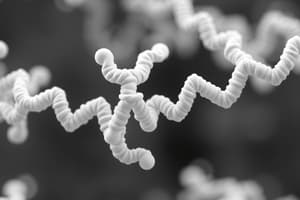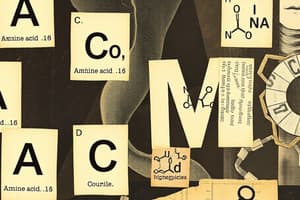Podcast
Questions and Answers
Which type of amino acid contains polar functional groups, leading to hydrophilic behavior?
Which type of amino acid contains polar functional groups, leading to hydrophilic behavior?
- Nonpolar
- Semi-polar
- Acidic (correct)
- Basic
What characterizes acidic amino acids under physiological conditions?
What characterizes acidic amino acids under physiological conditions?
- They form negatively charged species (correct)
- They form positively charged species
- They are hydrophobic
- They lack charged functional groups
Which amino acid classification possesses both hydrophobic and hydrophilic characteristics?
Which amino acid classification possesses both hydrophobic and hydrophilic characteristics?
- Nonpolar (correct)
- Basic
- Polar
- Acidic
Why do nonpolar amino acids generally occur as small alkyl or aromatic side chains?
Why do nonpolar amino acids generally occur as small alkyl or aromatic side chains?
Which type of amino acid forms positively charged species under physiological conditions?
Which type of amino acid forms positively charged species under physiological conditions?
What distinguishes L-isomers from D-isomers in terms of protein synthesis participation?
What distinguishes L-isomers from D-isomers in terms of protein synthesis participation?
What is the primary structure of a protein?
What is the primary structure of a protein?
Which structure of a protein is characterized by the alpha-helix and beta-sheet arrangements?
Which structure of a protein is characterized by the alpha-helix and beta-sheet arrangements?
What stabilizes the secondary structures of proteins?
What stabilizes the secondary structures of proteins?
How is the tertiary structure of a protein defined?
How is the tertiary structure of a protein defined?
What type of bonds can contribute to the stability of the tertiary structure?
What type of bonds can contribute to the stability of the tertiary structure?
Which level of protein structure involves multiple polypeptide chains?
Which level of protein structure involves multiple polypeptide chains?
Flashcards
Primary Structure
Primary Structure
The linear sequence of amino acids within a polypeptide chain. It determines the protein's overall folding pattern and 3D shape.
Secondary Structure
Secondary Structure
Local arrangements of atoms within the polypeptide backbone, like alpha-helix or beta-sheet. These structures are stabilized by hydrogen bonds between specific amino acid residues.
Tertiary Structure
Tertiary Structure
The final 3D structure of a folded polypeptide chain. Interactions between different parts of the chain, like disulfide bonds, contribute to stability.
Quaternary Structure
Quaternary Structure
Signup and view all the flashcards
Nonpolar Amino Acids
Nonpolar Amino Acids
Signup and view all the flashcards
Polar Amino Acids
Polar Amino Acids
Signup and view all the flashcards
Acidic Amino Acids
Acidic Amino Acids
Signup and view all the flashcards
Basic Amino Acids
Basic Amino Acids
Signup and view all the flashcards
Semi-polar Amino Acids
Semi-polar Amino Acids
Signup and view all the flashcards
Amino Acid Chirality
Amino Acid Chirality
Signup and view all the flashcards
Amino Acid Sequence
Amino Acid Sequence
Signup and view all the flashcards
Subunits
Subunits
Signup and view all the flashcards
Study Notes
Amino Acids and Proteins: Understanding Structure and Classification
Proteins are essential components of living organisms, serving various functions from structural support to catalytic processes. They are composed of amino acids, which function both individually and when combined into chains called polypeptides. In this article, we will explore the structures of proteins and how they are formed by amino acids, as well as classifying these building blocks based on their chemical properties.
Protein Structure
Proteins have a hierarchical organization of structure, ranging from primary to tertiary and quaternary levels. The primary structure refers to the linear sequence of amino acids within the polypeptide chain. This sequence determines the overall folding pattern and ultimate three-dimensional shape of the protein.
The secondary structure is characterized by a local arrangement of atoms within the polypeptide backbone, such as the alpha-helix or the beta-sheet. These structures are stabilized through hydrogen bonding between certain amino acid residues.
At the tertiary level, the entire folded polypeptide chain acquires its final three-dimensional structure due to the interactions among different parts of the chain. Disulfide bonds between cysteine residues can contribute to this stability.
Finally, some proteins consist of multiple polypeptide chains, forming the quaternary structure. Each individual polypeptide chain is referred to as a subunit, and the association of two or more subunits results in higher order oligomeric forms.
Amino Acid Classification
Amino acids are classified according to several criteria, including the presence or absence of functional groups and side chains:
-
Nonpolar: They lack charged functional groups and generally occur as small alkyl or aromatic side chains, allowing them to be embedded within the nonpolar environment of the lipid bilayer. Examples include leucine, valine, methionine, and phenylalanine.
-
Polar: These amino acids contain polar functional groups, either neutral (hydroxyl) or charged (carboxylic acid), leading to hydrophilic behavior. Examples include serine, threonine, tyrosine, glutamic acid, and lysine.
-
Acidic: Typically containing carboxylic acid groups, these amino acids form negatively charged species under physiological conditions. Examples include aspartic acid and glutamic acid.
-
Basic: Containing an amino group, these amino acids form positively charged species under physiological conditions. Examples include arginine, histidine, and lysine.
-
Semi-polar: Amino acids with semi-polar nature possess both hydrophobic and hydrophilic characteristics. For example, glycine's single hydrogen atom makes it a relatively hydrophilic amino acid, while its small size makes it relatively hydrophobic.
Amino acids also differ in terms of chirality; each molecule has two possible stereoisomers, designated L (levorotatory) and D (dextrorotatory). Most amino acids found in proteins are L-isomers, while D-isomers do not typically participate in protein synthesis.
In summary, understanding the structure of proteins requires knowledge of amino acid sequences and their arrangements in space. Furthermore, comprehending the chemical properties of amino acids helps in predicting how these elements interact with one another and ultimately determine protein function.
Studying That Suits You
Use AI to generate personalized quizzes and flashcards to suit your learning preferences.




